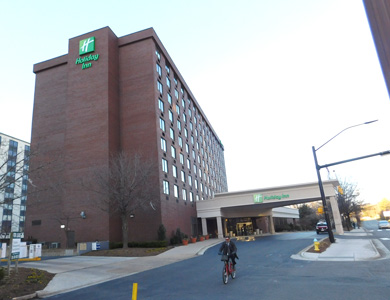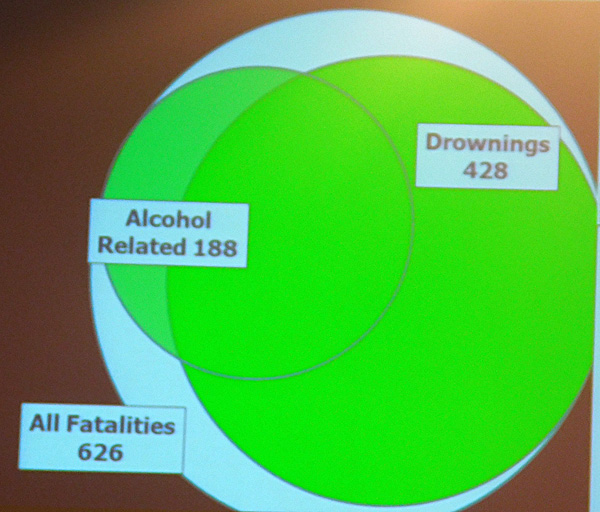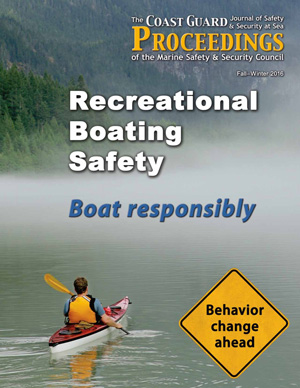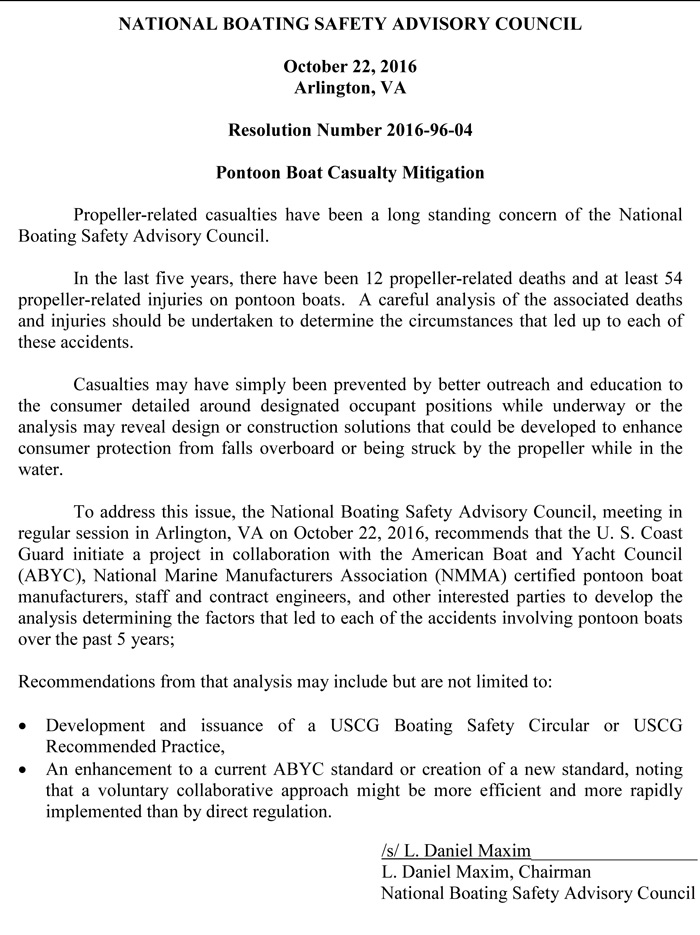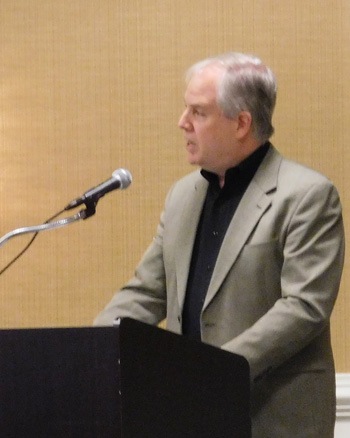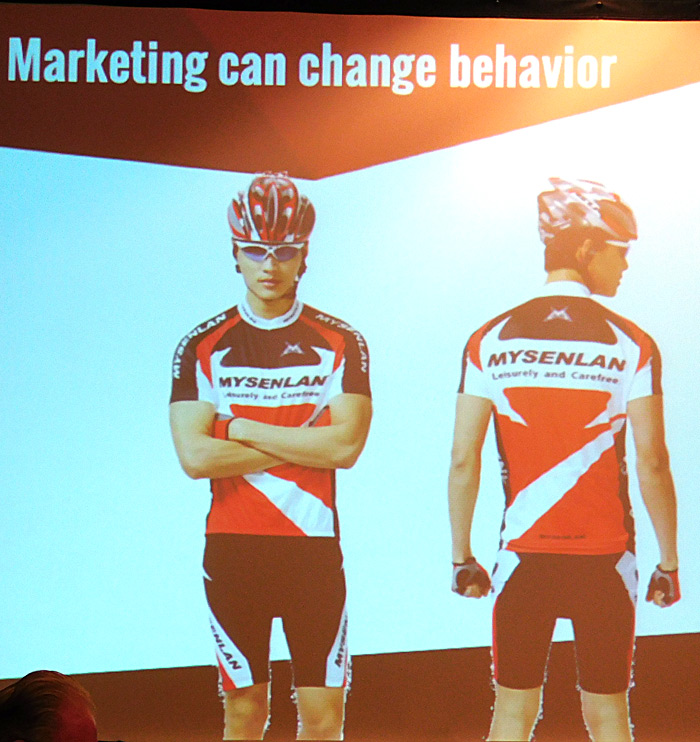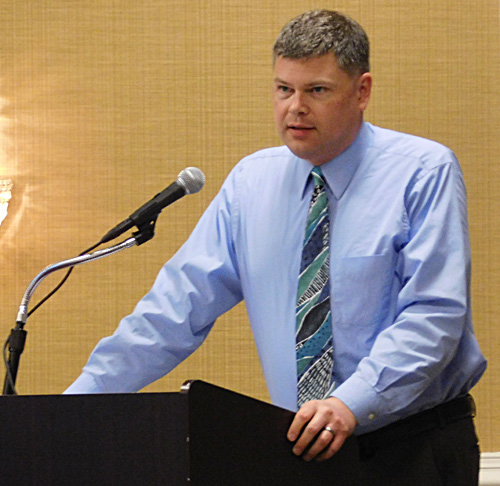U.S. Coast Guard NBSAC97 meeting part 1
The meeting was held in the ballroom of the Holiday Inn in Ballston in Arlington.
The meeting room was setup with tables forming a horseshoe at the front of the room, with the open end of the horseshoe facing the public seating area. Each Council member had their own microphone. A microphone stand in front of the public area was used for public comment.
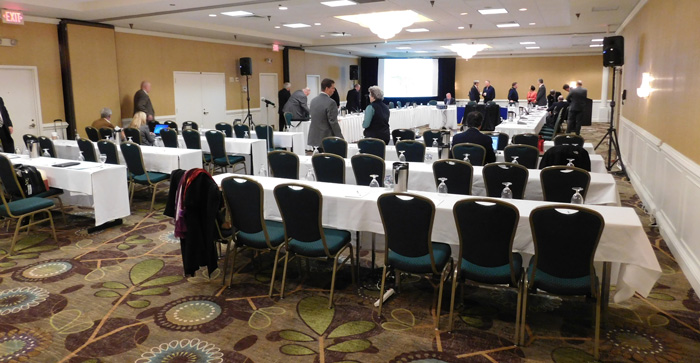
NBSAC97 room layout. See the horseshoe arrangement of tables at front (toward the projection screen) for the Council. Public sits in the back.
Changing of the Guard
Captain Vern B. Gifford (CG-5PC). Chief of Inspections and Compliance will be separating on May 5th. He is over a number reports including Captain Boross.
Captain Boross (CG-BSX), over the Boating Safety Office and the Auxilary since about 2013 will retiring April 11th. He will be replaced by Captain Select Scott Johnson. Captain Boross noted, they while he was an aviator, we would be getting an engineer from the marine side in Captain Select Johnson.
Jeff Hoedt (CG-BX2), leader of the Boating Safety Division for over a decade, retired. His last full day was the last day of the meeting. He will be temporarily replaced by Paublo Oborski of USCG, previously of the Grants division. Applications for the position have since closed and USCG will be determining Mr. Hoedt’s successor in the future. Meanwhile, Mr. Oborski will be the interim leader.
By May 5th 2017, Jeff Hoedt, the face many of us know as representing the boating safety office will be gone, along with his boss, and his boss’s boss.
Non-profit Grants
The Coast Guard annually awards about $5 million in grants to non-profits for boating safety projects. 2017 non-profit grants winners have not yet been announced so the non-profits in attendance may have been a little distracted.
A few non-profits, or non-profit arms of for profit organizations are on the Council. If you are a member of the Council you are likely in a better position to understand recent USCG concerns and motivations, develop a relationship with those representing USCG, and better target what USCG actually wants with your grant proposals. Plus you get your NBSAC travel expenses paid for. A couple years back there were some complaints about this. An Administrative Investigation prescribed some actions to make sure the playing field is reasonably level for all involved.
Opening Remarks
Chairman Dan Maxim showed the first of several Venn Diagrams seen during the meeting. This one showed the total number of boating deaths for a previous year, the number of deaths due to drowning, the number of deaths due to alcohol, and number of deaths in which both were a factor.
Mr. Maxim, and thus the Council, is very big on Venn Diagrams. He returned this one several times during the meeting.
Mr. Maxim noted the Council should be spending its efforts on these two large circles, and maybe an effort now and then on the remaining white space. We should not be outside of the large white circle.
NBSAC Updates
Captain Boross speaking
The annual statistics have yet to be issued, but the death count is up. In January they announced the 2016 death toll was at 691, but it has since risen to 702, and is still rising. That is already 76 more souls than died in 2015.
Injuries, accidents, and fatalities are all up. It was the worst July in a decade. The trend line screams upward from the low in 2013 that was in the 500’s.
Many times during the three day meeting, Captain Boross brought up the recent Fall-Winter issue of The Coast Guard Proceedings. The entire issue is devoted to boating safety. Many members of NBSAC contributed articles to the Proceedings and he thanked them for their efforts. He also noted how he was able to use it to communicate with others when he was talking about a topic by pointing out the relevant article in Proceedings.Captain Boross was given an award for his service.
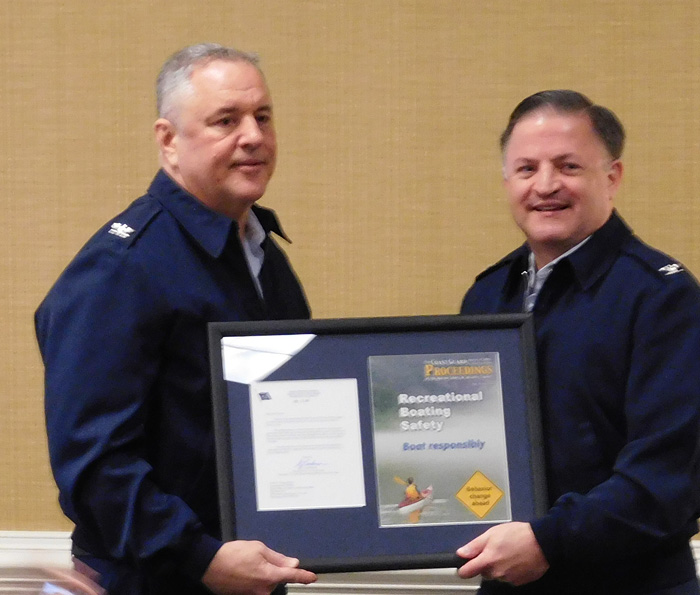
Captain Boross (left) receives award from Captain Gifford (right). Award shows the Proceedings magazine.
Jeff Hoedt speaking
The background checks now required by the Auxiliary are a struggle for volunteers.
Don Kerlin is now chief of two divisions, (1)Program Management and (2) Operations.
There was discussion of the Sport Fish Restoration and Boating Trust Fund. It is funded by the Federal government rebating the portion of road taxes paid on boat fuel and by import duties on fishing equipment. The Coast Guard was a little surprised it was recently re-authorized. There are currently 3 expiration dates. They are going to try to get them all back to the same date as they once were. The Coast Guard’s portion of those funds goes to fund projects at state boating safety offices (about $100 million) and about $5 million goes to grants to non-profit boating safety organizations for projects selected by USCG.
USCG questions the boat registration data in 4 to 6 states. California is the big one. It bumps up and down over time, and they know there have been some droughts, but the continuing falloff in registration catches their eye. This data is important because boat registrations in three size categories are turned in to the federal government for use in calculating the amount of fuel taxes to be rebated to the Trust Fund.
In 2016 the industry reported a 6 percent increase in boat sales, most of that being power boats. So USCG hoped to see higher registration numbers, but instead total registrations were slightly down.
The life jacket wear rate study shows there is some decrease in wear rates as compared to 2015. PWC life jacket wear rates remain high.
In cooperation with paddlecraft manufacturers, USCG printed 7 MILLION brochures for canoe and kayak safety. They have been given to the manufacturers for distribution in new boat packets. Printed enough to last a few years. Some will be distributed outside the U.S.. There is still a problem in Canada because the brochure is not available in French.
A similar effort is currently underway with paddleboard manufacturers to print a safety brochure for inclusion with new boards.
Resolution updates – there were about half a dozen resolutions at the last meeting.
(1) USCG to investigate other distress and alerting signals. There will be a report on those efforts during this meeting.
(2) Consolidate carriage requirements for safety equipment recreational boats (put the list of all the things that must be carried on a recreational boat into one regulation in one place, not have those requirements scattered around in multiple regulatory documents – get them out of 46 CFr and move them to 33 CFR). They are looking into that, but there are administrative restrictions. Regulatory changes are very difficult to make.
Regulatory efforts are basically dead. They have faced considerable challenges in issuing regulations the last several years Now with the new administration (Pres. Trump) new regulations are no longer an effective option for the Coast Guard Office of Boating Safety.
(3) Update regulatory requirements for boat builders and boat equipment manufacturers in 33 CFR. Most of the needed updates have been listed. USCG agrees with the need for the update from the dark ages, but it is too challenging to update CFR (Code of Federal Regulations) at this time.
(4) Pontoon boat casualty mitigation. Will visit about this during the meeting.
(5) Study the relationship between on water boater safety training and reduced boater casualties. We will hear more today about efforts to make it more practical to offer on water boater training (skills training). There are currently regulatroy issues making it challenging to offer on water boater safety training. It will be discussed further at this meeting.
(6) Increased emphasis on human factors. They want USCG to study to role of human factors in recreational boating accidents with the idea being how to reduce the number of accidents. USCG concurs but is looking at how this might be accomplished. Will it be done through a grant, a contract, be done by staff, be done through stakeholder entities. Are seeking guidance. It was identified as the top priority at the last meeting.
National Transportation Safety Board (NTSB) recently released the Shared Waterways Safety Recommendation Report. The report focuses on safety issues in areas where recreational boats share the waterways with commercial vessels, some of which are quite large. A copy of the report was supplied with the meeting materials.
As of January 20th, all of our regulatory projects are frozen. Plus January 24th they were told that for every new regulation they will have to give up / kill two existing regulations.
Captain Boross speaking
We work for the Coast Guard’s Chief Office of Prevention. Within his arsenal he has compliance, inspection, and outreach resources. So you have the Federal situation right now. So what are we going to do about it? USCG will now be emphasize as passionately and we can and fund as astutely as we can those outreach efforts. He said, “Outreach is the tool available to us. … Help up optimize the outreach opportunities that we have.”
I did not think of it at that time, but now suspect it was on the mind of the non-profits in the room, does all this emphasis on outreach mean USCG will be putting more funds into the non-profit grant program? That question was not publicly asked, but I suspect the non-profits were thinking about it.
Jeff Hoedt speaking
Recognized Barry Nobles and the good work he has been doing alongside Jeff with legislative issues. They are being called to the hill this afternoon to provide some information they would likely have not been called for in the past because the legislature now trusts them and can learn things from them.
How to Design an Effective Outreach Campaign:
“Challenges and Opportunities in Recreational Boating Safety Outreach”
The overall objective of marketing is to change behavior.
He noted how adult life jacket wear rates in open motorboats has hovered at 5 percent for years. It is very difficult, expensive, and time consuming to change behavior.
Digital marketing is more affordable and more measurable than anything has ever been.
The lack of efficiency is obvious. You can spend a lot of money advertising to people that never step foot in a boat. Digital marketing is exactly the opposite.
Digital media allows you to precisely select your audience and not pay til they click on a link to engage with you.
Nowdays you can place video Public Service Announcements online vs. begging stations for air time.
He talked about their being much to learn from the field of Behavioral Economics and listed three well known experts in that field: Daniel Kahneman, Dan Ariely, and Cass Sunstein.
Several times Mr. Sprague referenced how bicyclist dress and showed an image of the classic biker wearing a helmet, cycling jersey, biker shorts, shades, gloves, etc. It has become cool to dress like that, even though it looks silly. Through marketing that has become the way you bike. He noted to the comparison to wearing life jackets.
Its called a marketing campaign because its a war.
During the questions, Pam Dillon of NASBLA noted that in the past they had shown hock and awe to focus groups, showed them tragedy and accidents. She said they had met some, she does not want to call it resistance, but the industry was concerned people would not have desire to go boating because they got an impression it was dangerous. How would you address that? Give us any advice on how to work that balance between that dynamic? Mr. Sprague, “Its never easy.” “Pam is addressing the fact that as marketers and safety advocates we’d love to go out with an unambiguous message and scare boaters into compliance and people who sell boats and boating equipment have a problem with some of that and I don’t blame them.”
Mr. Sprague continued –
Nobody wants to tell boaters that boating is a dangerous sport. It really isn’t. But there are things you need to do to protect yourself. These are people that want to go boating, they want to relax, they want to have a good time, they want to be free. How can we connect that with a few simple activities to make them a lot safer. I don’t know. That is a tough one for sure. The ad showed earlier with the young woman texting while driving in an accident was funded by AT&T. No one is saying don’t use cell phones, but they are clearly seeing some PR value in supporting an awareness campaign there. I don’t have a magic pill to answer that questions, but I would go to the behavior and what’s going to motivate the behavior. In some cases in may be a greater perception of danger, in others it might be some other thing.
PropellerSafety.com note – what everybody was thinking about and nobody mentioned was all the ruckus surrounding Dont Wreck Your Summer, a propeller safety PSA a few years back. It was pulled by USCG due to industry objections.
On occasion, top flight ad agencies do pro bono work for causes, like the Argentine Organ Donor PSA designed and produced by DDB titled, The Man and the Dog. Such PSA’s can have tremendous impact. Mr. Maxum, chairman of NBSAC, noted Argentina now ranks very high in organ donors. He also suggested USCG might beg for similar free assistance.
Captain Boross thanked Mr. Sprague for his presentation. Captain Boross said we want to reach the aspirational (starter) boater. We need compelling content. We need to take our knowledge and ask provacative questions.
2017 National Recreational Boating Safety Survey
Methods and status of the 2017 boating safety survey were discussed by Don Kirland (USCG) and Ed Mahoney of Michigan State.
They met with the grantee, RTI, yesterday and are ready to launch it. The study will now be done on three year rotation to reduce costs. This one will be a national study. It will not supply state by state data as has been done in the past.
It will supply to total number of person days by boat type and size.
It was noted that much of the same data is need by both marketing and safety. Facilities and amenities (like marinas) also need similar data.
Exposure data will be collected close to the point/location of activity and close to when it happened.
There will be two surveys:
(1) Participation – the whole country as a whole
(2) Exposure – will produce state level data for 43 states, this increases the cost of the study
They have 174,000 good addresses. There will be 30,000 surveys.
December 17-January 18th will be the participation study
Exposure data will be collected every month. They will ask for exposure time by daylight and by dark hours.
The surveys will be mailed along with an incentive, nobody completes a phone survey any more.
There was some discussion about going to a 5 year study. A recommendation was made to collect the participation data every 5 years, and the exposure study every 2 years.
The results will be available in SAS and Excel format, both raw data and clean data, plus a query system will be available.
Grants
Paublo Oborski gave the grant update. Fiscial Year 2016 will see about $106 million going to the states and about $5.3 million to non-profit grants.26 attended the grant training session in Florida.
END of part 1 of our coverage
Links to the meeting agenda and all 5 parts of our NBSAC97 coverage are below.
